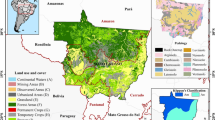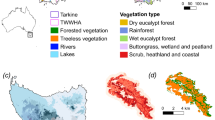Abstract
Agricultural burning is an important land use practice in the central U.S. but has received little attention in the literature, whereas most of the focus has been on wildfires in forested areas. Given the effects that agricultural burning can have on biodiversity and emissions of greenhouse gasses, there is a need to quantify the spatial and temporal patterns of fire in agricultural landscapes of the central U.S. Three years (2006–2008) of the MODIS 1 km daily active fire product generated from the MODIS Terra and Aqua satellite data were used. The 2007 Cropland Data Layer developed by the U.S. Department of Agriculture was used to examine fire distribution by land cover/land use (LCLU) type. Global ordinary least square (OLS) models and local geographically weighted regression (GWR) analyses were used to explore spatial variability in relationships between fire detection density and LCLU classes. The monthly total number of fire detections peaked in April and the density of fire detections (number of fires/km2/3 years) was generally higher in areas dominated by agriculture than areas dominated by forest. Fire seasonality varied among areas dominated by different types of agriculture and land use. The effects of LCLU classes on fire detection density varied spatially, with grassland being the primary correlate of fire detection density in eastern Kansas; whereas wheat cropping was important in central Kansas, northeast North Dakota, and northwest Minnesota.








Similar content being viewed by others
References
Anderson R (1990) The historic role of fire in the North American grassland. In: Collins SL, Wallace LL, American Institute of Biological Sciences, Ecological Society of America, Botanical Society of America (eds), Fire in North American tallgrass prairies, 1st edn. University of Oklahoma Press, Norman [Okla.], pp 8–18
Archibald S, Roy DP, van Wilgen BW, Scholes RJ (2009) What limits fire? An examination of drivers of burnt area in Southern Africa. Glob Chang Biol 15(3):613–630
Bivand R, Yu D (2008) spgwr: geographically weighted regression. available from http://ncg.nuim.ie/ncg/GWR/index.htm
Bond WJ (2005) Large parts of the world are brown or black: a different view on the “Green World” hypothesis. J Veg Sci 16:261–266
Bond WJ, Keeley JE (2005) Fire as a global “herbivore”: the ecology and evolution of flammable ecosystems. Trends Ecol Evol 20:387–394
Bragg TB (1982) Seasonal variations in fuel and fuel consumption by fires in a bluestem prairie. Ecology 63:7–11
Bragg TB (1995) The physical environment of the Great Plains grasslands. In: Joern A, Keeler KH (eds) The changing prairie: North American grasslands. Oxford University, New York; Oxford, pp 49–81
Brockett BH, Biggs HC, van Wilgen BW (2001) A patch mosaic burning system for conservation areas in southern African savannas. Int J Wildland Fire 10(2):169–183
Brunsdon C, Fotheringham S, Chariton M (1998) Geographically weighted regression-modeling spatial non-stationarity. The Statistician 47:431–443
Chen Y, Tessier S, Cavers C, Xu X, Monero E (2005) A survey of crop residue burning practices in Manitoba. Appl Eng Agric 21(3):317–323
Cook JG, Hershey TJ, Irwin LL (1994) Vegetative response to burning on Wyoming mountain-shrub big game ranges. J Range Manag 47(4):296–302
Csiszar I, Justice CO, McGuire AD, Roy DP, Brown F, Conard SG, Frost PGH, Giglio L, Elvidge C, Flannigan MD, Kasischke E, McRae DJ, Rupp TS, Stocks BJ, Verbyla DL (2004) Land use and fires. In: Gutman G (ed), Land change science: observing, monitoring and understanding trajectories of change on the Earth’s surface, vol 6. Kluwer Academic Publishers, Dordrecht; London, pp xix, 459 p
Dickson BG, Prather JW, Xu Y, Hampton HM, Aumack EN, Sisk TD (2006) Mapping the probability of large fire occurrence in northern Arizona, USA. Landscape Ecol 21:747–761
Eva H, Lambin EF (1998) Remote sensing of biomass burning in tropical regions: sampling issues and multisensor approach. Remote Sens Environ 64(3):292–315
Fotheringham AS, Brunsdon C, Charlton M (2002) Geographicallyweighted regression: the analysis of spatially varying relationships. Wiley, Hoboken, NJ
Fuhlendorf SD, Engle DM (2004) Application of the fire-grazing interaction to restore a shifting mosaic on tallgrass prairie. J Appl Ecol 41(4):604–614
Fuhlendorf SD, Harrell WC, Engle DM, Hamilton RG, Davis CA, Leslie DM (2006) Should heterogeneity be the basis for conservation? Grassland bird response to fire and grazing. Ecol Appl 16(5):1706–1716
Giglio L (2005) MODIS collection 4 active fire product user’s guide version 2.2. 42 pp
Giglio L (2007) Characterization of the tropical diurnal fire cycle using VIRS and MODIS observations. Remote Sen Environ 108(4):407–421
Giglio L, Descloitres J, Justice CO, Kaufman YJ (2003) An enhanced contextual fire detection algorithm for MODIS. Remote Sens Environ 87(2–3):273–282
Hawbaker TJ, Radeloff VC, Syphard AD, Zhu Z, Stewart SI (2008) Detection rates of the MODIS active fire product in the United States. Remote Sens Environ 112(5):2656–2664
Higgins KF (1986) Interpretation and compendium of historical fire accounts in the northern Great Plains [microform]. U.S. Dept. of the Interior, Fish and Wildlife Service, Washington, D.C
Howe HF (1994) Response of early-flowering and late-flowering plants to fire season in experimental prairies. Ecol Appl 4(1):121–133
Johnson County Environmental Department Air Quality Program (2009) Available from http://www.sharetheair.com/docs/pn/sip/Appendix12_1.pdf. Accessed 23 Feb 2009
Justice CO, Giglio L, Korontzi S, Owens J, Morisette JT, Roy DP, Descloitres J, Alleaume S, Petitcolin F, Kaufman Y (2002) The MODIS fire products. Remote Sens Environ 83(1–2):244–262
Kaufman YJ, Justice CO, Flynn LP, Kendall JD, Prins EM, Giglio L, Ward DE, Menzel WP, Setzer AW (1998) Potential global fire monitoring from EOS-MODIS. J Geophys Res-Atmos 103(D24):32215–32238
Korontzi S, McCarty J, Loboda T, Kumar S, Justice C (2006) Global distribution of agricultural fires in croplands from 3 years of Moderate Resolution Imaging Spectroradiometer (MODIS) data. Global Biogeochem Cycles 20(2):15
Korontzi S, McCarty J, Justice C (2008) Monitoring agricultural burning in the mississippi River Valley Region from the moderate resolution imaging spectroradiometer (MODIS). J Air Waste Manag Assoc (1995) 58(9):1235–1239
Lal R (2004) Agricultural activities and the global carbon cycle. Nutr Cycl Agroecosyst 70(2):103–116
Leff B, Ramankutty N, Foley JA (2004) Geographic distribution of major crops across the world. Global Biogeochem Cycles 18(1):33
Lemieux PM, Lutes CC, Santoianni DA (2004) Emissions of organic air toxics from open burning: a comprehensive review. Prog Energy Combus Sci 30(1):1–32
McCarty JL, Justice CO, Korontzi S (2007) Agricultural burning in the Southeastern United States detected by MODIS. Remote Sens Environ 108(2):151–162
McCarty JL, Loboda T, Trigg S (2008) A hybrid remote sensing approach to quantifying crop residue burning in the United States. Appl Eng Agric 24(4):515–527
McCool DK, Pannkuk CD, Kennedy AC, Fletcher PS (2008) Effects of burn/low-till on erosion and soil quality. Soil Tillage Res 101(1–2):2–9
Moghaddas EEY, Stephens SL (2007) Thinning, burning, and thin-burn fuel treatment effects on soil properties in a Sierra Nevada mixed-conifer forest. For Ecol Manag 250(3):156–166
Morisette JT, Giglio L, Csiszar I, Justice CO (2005a) Validation of the MODIS active fire product over Southern Africa with ASTER data. Int J Remote Sens 26(19):4239–4264
Morisette JT, Giglio L, Csiszar I, Morisette JT, Giglio L, Csiszar I, Setzer A, Schroeder W, Morton D, Justice CO (2005b) Validation of MODIS active fire detection products derived from two algorithms. Earth Interact 9:25
NRCS (2007) National Resources Inventory 2003 NRI, land use. U.S. Department of Agriculture, Natural Resources Conservation Service, USA
Park RJ, Jacob DJ, Logan JA (2007) Fire and biofuel contributions to annual mean aerosol mass concentrations in the United States. Atmos Environ 41(35):7389–7400
Perlack RD, Wright LL, Turhollow AF, Graham RL (2005) Biomass as feedstocks for a bioenergy and bioproducts industry: the technical feasability of a billion-ton annual supply. U.S. Department of Energy. Report: DOE/GO-102005-2135. Oak Ridge, TN
R Development Core Team (2008) R: a language and environment for statistical computing. R Foundation for Statistical Computing, Vienna, Austria
Reid SB, Funk TH, Sullivan DC, Stiefer PS, Arkinson HL, Brown SG, Chinkin LR (2004) Research and development of emission inventories for planned burning activities for the Central State Regional Air Planning Association. In: 13th international emission inventory conference proceedings, Clearwater, Fla. 2004. Available from http://www.epa.gov/ttnchie1/conference/ei13/rpo/funk.pdf. Accessed 15 July 2010
Reinking DL (2005) Fire regimes and avian responses in the central tallgrass prairie. Stud Avian Biol 30:116–126
Roy DP, Boschetti L, Justice CO, Ju J (2008) The collection 5 MODIS burned area product—global evaluation by comparison with the MODIS active fire product. Remote Sens Environ 112(9):3690–3707
Smith R, Adams M, Maier S, Craig R, Kristina A, Maling I (2007) Estimating the area of stubble burning from the number of active fires detected by satellite. Remote Sens Environ 109(1):95–106
Steinauer EM, Collins SL (1996) Prairie ecology—the tallgrass prairie. In: Samson FB, Knopf FL (eds) Prairie conservation: preserving North America’s most endangered ecosystem. Island Press, Washington, DC, pp 39–52
Stern AJ, Doraiswamy PC, Cook PW (2001) Spring wheat classification in an AVHRR image by signature extension from a landsat TM classified image. Photogramm Eng Remote Sens 67(2):207–211
Syphard AD, Radeloff VC, Keuler NS, Taylor RS, Hawbaker TJ, Stewart SI, Clayton MK (2008) Predicting spatial patterns of fire on a southern California landscape. Int J Wildland Fire 17:602–613
USDA/JAWF (1994) Major world crop area and climatic profiles. Agricultural Handbook No. 664
USDA-NASS (2005). USDA-NASS published estimates database. Available from http://www.nass.usda.gov/Data_and_Statistics/Quick_Stats/index.asp. Accessed 1 July 2009
Wilgers DJ, Horne EA (2006) Effects of different burn regimes on tallgrass prairie herpetofaunal species diversity and community composition in the Flint Hills, Kansas. J Herpetol 40(1):73–84
Wolfe RE, Roy DP, Vermote E (1998) MODIS land data storage, gridding, and compositing methodology: level 2 grid. IEEE Trans Geosci Remote Sens 36(4):1324–1338
Yang J, He HS, Shifley SR, Gustafson EJ (2007) Spatial patterns of modern period human-caused fire occurrence in the Missouri Ozark Highlands. For Sci 53:1–15
Yevich R, Logan JA (2003) An assessment of biofuel use and burning of agricultural waste in the developing world. Global Biogeochem Cycles 17(4):42
Acknowledgments
This research was supported in part by a NASA EPSCoR project entitled Land cover dynamics, regional hydrometeorology, and the vulnerability of rain-fed agriculture to climate change under scenarios of extensive cultivation of biofuel feedstocks (NNX07AT61A) and by the US Department of Energy through the Sun Grant Initiative’s Regional Biomass Feedstock Partnership. We thank Dr. Luigi Boschetti for help with MODIS data processing. We thank two anonymous reviewers for helpful comments on an earlier draft.
Author information
Authors and Affiliations
Corresponding author
Rights and permissions
About this article
Cite this article
Tulbure, M.G., Wimberly, M.C., Roy, D.P. et al. Spatial and temporal heterogeneity of agricultural fires in the central United States in relation to land cover and land use. Landscape Ecol 26, 211–224 (2011). https://doi.org/10.1007/s10980-010-9548-0
Received:
Accepted:
Published:
Issue Date:
DOI: https://doi.org/10.1007/s10980-010-9548-0




